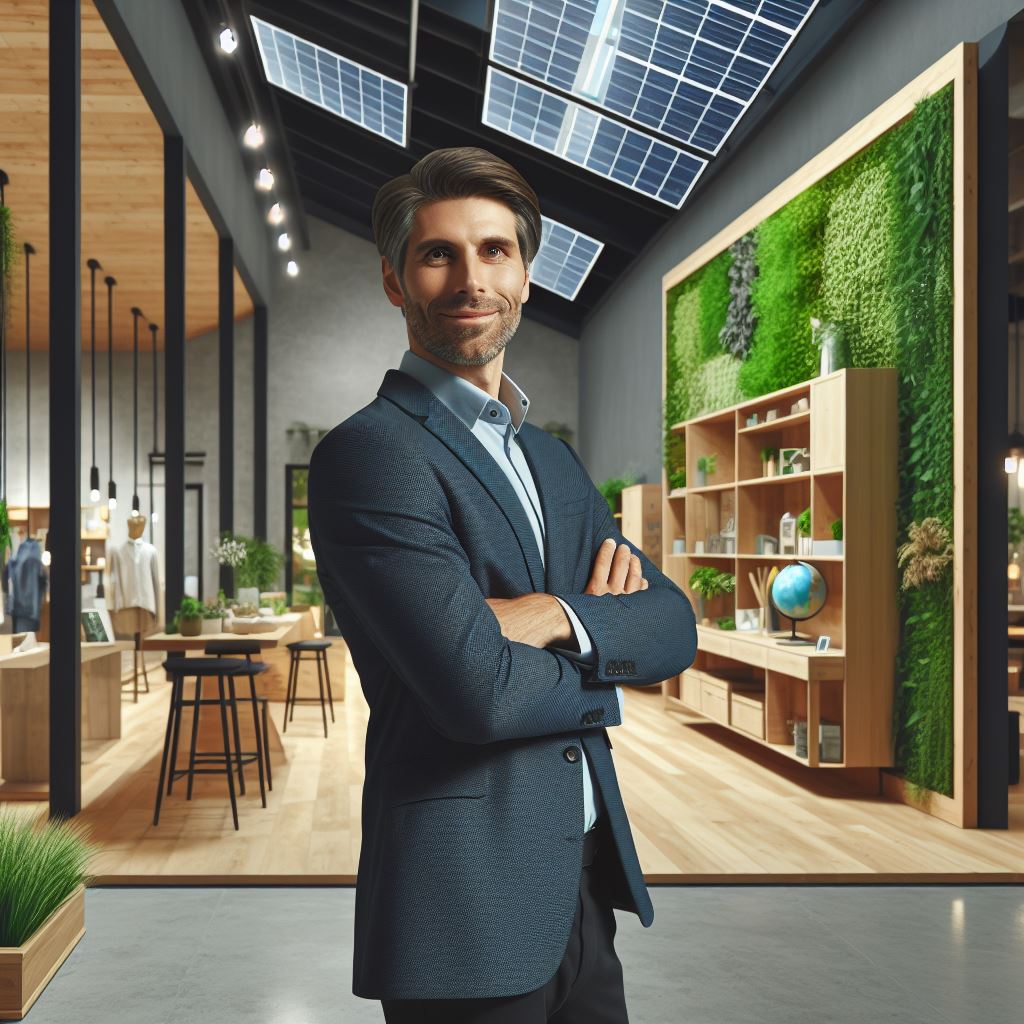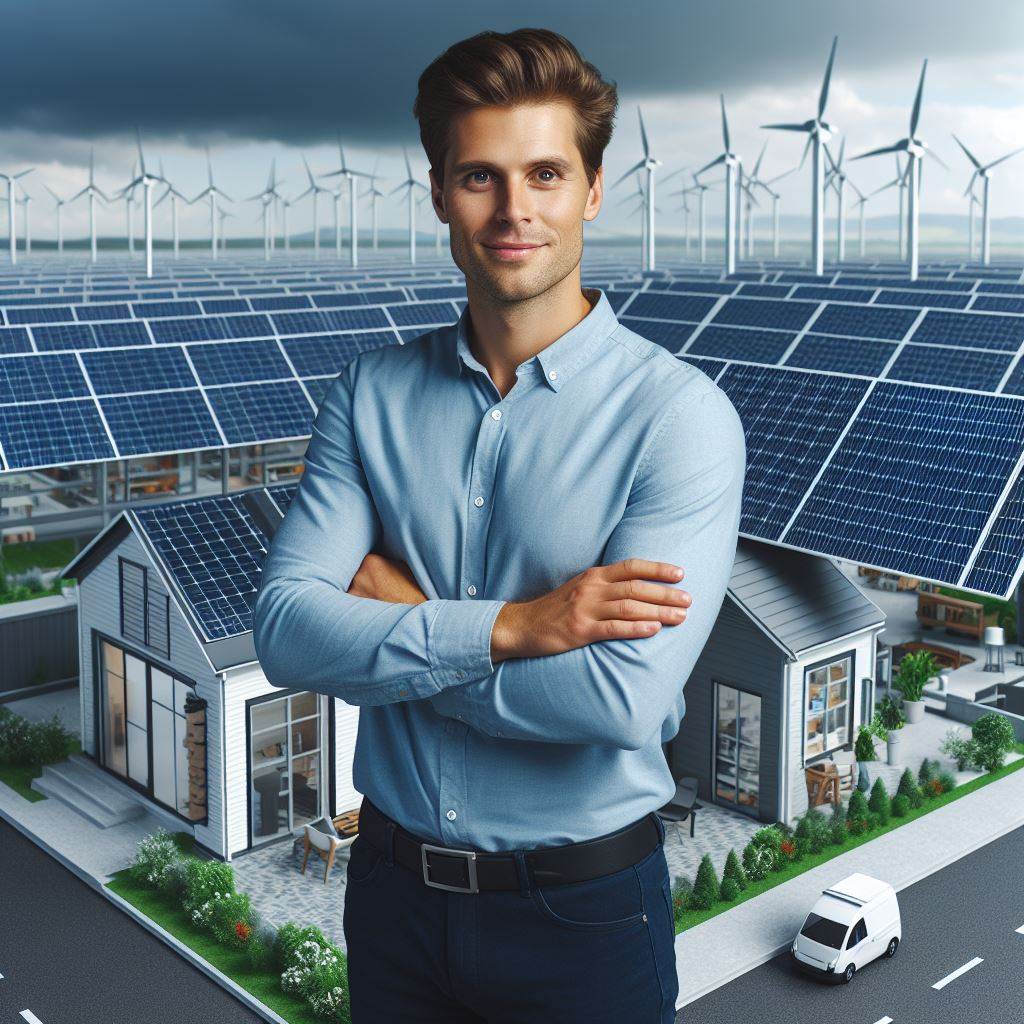Introduction
With the current state of the real estate industry witnessing rapid expansion and evolution, it has become imperative to embrace environmentally friendly practices.
The growing emphasis on sustainability and adopting eco-friendly approaches is transforming the way offices are designed and constructed.
The traditional mindset of focusing solely on maximizing profit margins has shifted towards recognizing the importance of minimizing ecological impact.
This change can be attributed to the increasing awareness about climate change and the urgent need to combat its adverse effects.
Eco-friendly offices are now considered more than just a trend; they have become a necessity.
The real estate industry is recognizing the significance of incorporating green building materials, energy-efficient technology, and renewable energy sources into office spaces.
This shift is not only towards environmental benefits but also towards economic benefits, as these practices result in reduced operating costs and increased property value.
Furthermore, eco-friendly practices extend beyond the physical infrastructure of offices.
Developers are now implementing initiatives such as recycling programs, waste reduction strategies, and eco-conscious transportation options.
These measures not only contribute to a healthier environment but also enhance the overall well-being of office occupants.
In fact, the real estate industry is witnessing a new era where the adoption of eco-friendly practices is becoming a prominent trend.
The shift towards sustainability is reshaping the way offices are designed, constructed, and operated.
Ultimately, eco-friendly offices benefit both the environment and the stakeholders involved.
Benefits of Eco-Friendly Offices
Eco-friendly offices offer numerous benefits that make them a desirable choice for businesses.
By adopting energy-efficient measures and conservation practices, these offices minimize their ecological footprint.
Reduced Ecological Footprint
One of the key benefits is the reduced use of energy.
Through energy-efficient technologies and conservation measures, resources like electricity and water are conserved, resulting in a lower environmental impact.
Additionally, eco-friendly offices rely on renewable energy sources to minimize their dependence on non-renewable fossil fuels.
By incorporating solar panels and wind turbines, these offices generate their own clean energy, reducing their carbon emissions and contributing to a greener future.
Smart technology plays a crucial role in eco-friendly offices, optimizing resource utilization.
Automated lighting systems, occupancy sensors, and smart thermostats help regulate energy consumption, ensuring resources are used efficiently.
Financial Savings
Financial savings are another major advantage of eco-friendly offices.
By implementing energy-efficient practices, utility costs are significantly reduced.
Lighting systems that use LED bulbs consume less electricity, and efficient HVAC systems minimize the use of heating and cooling energy.
Moreover, governments often provide tax incentives to businesses that adopt green initiatives.
These incentives further motivate companies to invest in eco-friendly practices, resulting in long-term financial benefits.
Health and Well-being of Occupants
The health and well-being of occupants are also prioritized in eco-friendly offices.
Indoor air quality is improved by proper ventilation, air filtration systems, and the use of non-toxic building materials.
Natural light and access to green spaces positively impact the mental and physical health of employees.
Exposure to natural light boosts mood and productivity, while green spaces create a calming and relaxing atmosphere, reducing stress levels.
Noise reduction techniques, such as acoustic panels and soundproofing materials, create a quieter and more focused work environment.
This improves concentration levels and overall comfort for employees.
In short, eco-friendly offices offer multiple benefits, ranging from reduced ecological footprint to financial savings and improved occupant well-being.
Implementing energy-efficient technologies, utilizing renewable energy sources, and making use of smart technology contribute to the overall sustainability and success of these offices.
Read: Green Building Trends in Commercial Real Estate
Eco-Friendly Design and Construction
Green building certifications
Green building certifications play a crucial role in ensuring that offices are constructed and designed in an eco-friendly manner.
Among these certifications, LEED certification stands out for its significance in promoting sustainable practices.
By adhering to LEED standards, developers and building owners can reduce their environmental footprint and contribute to a more sustainable real estate sector.
Another notable certification is the WELL Building Standard, which focuses specifically on occupant health and well-being.
Incorporating elements such as natural light, proper ventilation, and ergonomic design, WELL-certified offices provide a healthier and more productive working environment.
This certification recognizes the importance of creating spaces that prioritize the well-being of individuals while minimizing negative impacts on the environment.
Sustainable materials and techniques
In addition to certifications, the use of sustainable materials and techniques in eco-friendly office construction is essential.
One way to achieve this is by utilizing recycled and locally sourced materials.
This approach reduces the demand for virgin materials, saves energy, and supports local economies.
Incorporating materials like reclaimed wood and recycled steel not only adds character to the office space but also reduces waste and carbon emissions.
Efficient water and waste management systems are also critical components of eco-friendly office design.
Implementing technologies such as low-flow fixtures and water collection systems helps conserve water resources.
Additionally, well-designed waste management systems, including recycling programs and composting, enable offices to reduce their overall waste and contribute to a circular economy.
Green roofs and vertical gardens are innovative ways to incorporate nature into office buildings.
Green roofs provide insulation, reduce urban heat island effect, and improve stormwater management.
These vegetated spaces also offer employees a tranquil environment, which promotes mental well-being and productivity.
Vertical gardens, on the other hand, utilize vertical space to grow plants, improving air quality and creating aesthetically pleasing indoor environments.
By prioritizing eco-friendly design and construction practices, offices can significantly reduce their environmental impact while providing healthier and more sustainable workplaces.
Green building certifications like LEED and the WELL Building Standard ensure that strict standards are met, leading to long-term benefits for both the environment and occupants.
Furthermore, incorporating sustainable materials and techniques, such as using recycled materials and efficient water management systems, further enhance the eco-friendliness of the office space.
The inclusion of green roofs and vertical gardens adds an element of nature, improving air quality and overall well-being.
Collectively, these efforts contribute to a new real estate era that embraces eco-friendly practices and prioritizes sustainability.
Read: Chicago’s 2024 Commercial Property Boom Explained

Eco-Friendly Office Features
Creating an eco-friendly office space is not just a trend but a necessity in today’s world.
With concerns about climate change and environmental conservation, businesses are increasingly seeking ways to reduce their carbon footprint and promote sustainability.
One area where significant progress has been made is in the development of energy-efficient office features.
Energy-efficient lighting systems
A key element of any eco-friendly office is the use of energy-efficient lighting systems.
Traditional incandescent bulbs are now being replaced by energy-saving LED lights, which consume up to 75% less energy and last much longer.
Motion sensors can also be installed to ensure that lights are only used when necessary, further reducing energy waste.
Advanced HVAC systems with temperature and ventilation control
Another important feature is an advanced HVAC system with temperature and ventilation control.
These systems allow for the optimization of temperature and airflow, ensuring that energy is not wasted on cooling or heating unused areas.
By providing employees with a comfortable working environment while minimizing energy consumption, businesses can make significant energy savings.
Water-saving fixtures and efficient plumbing
Water conservation is also a crucial aspect of eco-friendly offices.
Installing water-saving fixtures such as low-flow toilets and faucets can significantly reduce water usage.
Efficient plumbing systems can further minimize water waste, contributing to overall sustainability efforts.
Integration of renewable energy sources like solar panels
Integrating renewable energy sources like solar panels is another effective way to make offices eco-friendly.
By harnessing the power of the sun, businesses can generate their own electricity and reduce reliance on fossil fuels.
This not only helps the environment but also offers long-term cost savings as the operational costs of solar panels continue to decrease.
Smart technology for energy monitoring and optimization
Lastly, incorporating smart technology for energy monitoring and optimization can greatly enhance the energy efficiency of office spaces.
Automated systems can track and analyze energy usage, identifying areas where improvements can be made.
This data-driven approach enables businesses to make informed decisions regarding energy consumption and further reduce their environmental impact.
In a nutshell, eco-friendly office features are essential in the new real estate era.
Energy-efficient lighting systems, advanced HVAC systems, water-saving fixtures, integration of renewable energy sources, and smart technology are key components that promote sustainability and reduce the environmental footprint of businesses.
Investing in eco-friendly office features not only benefits the planet but also improves the bottom line through long-term cost savings.
It’s time for businesses to embrace this new era and create office spaces that prioritize both productivity and environmental responsibility.
Read: Warehouse Investments: The 2024 Boom Explained
The Shift in Tenant Preferences
Increasing demand for sustainable office spaces
The current real estate market has seen a significant shift in tenant preferences towards eco-friendly office spaces.
With increasing awareness about environmental issues and the need for sustainable solutions, more and more companies are seeking out green offices.
These eco-friendly offices are equipped with energy-efficient technologies, use recycled and sustainable materials, and promote healthy and green practices.
The demand for such spaces has been driven by both corporate social responsibility initiatives and cost-saving benefits.
Tenants are realizing that choosing an eco-friendly office space not only aligns with their environmental values but also helps in reducing energy costs.
Green buildings often have lower operating costs due to their energy-efficient features, such as LED lighting, efficient HVAC systems, and solar panel installations.
Furthermore, sustainable office spaces also enhance employee productivity and well-being.
Studies have shown that green buildings with ample natural light, proper air ventilation, and access to outdoor spaces contribute to a more positive work environment, leading to increased job satisfaction and productivity.
Impact on rental rates and property value
The increasing demand for eco-friendly office spaces has also had an impact on rental rates and property value.
With a limited supply of such spaces, landlords are able to charge premium rents for green offices.
Moreover, sustainable features and certifications, such as LEED (Leadership in Energy and Environmental Design), can significantly boost the value of a property.
Investors and tenants are willing to pay higher prices for buildings that have achieved these certifications as they provide assurance of sustainable practices and environmental responsibility.
Property owners and landlords recognize the financial benefits of investing in green office spaces.
Not only do these spaces command higher rents, but they also attract long-term, high-quality tenants.
Companies that prioritize sustainability and social responsibility are more likely to lease such properties and commit to longer lease terms.
Attracting environmentally conscious companies and talent
The shift towards eco-friendly offices has not only impacted the demand for such spaces but has also raised the bar for attracting environmentally conscious companies and talent.
Companies that boast green office spaces are seen as leaders in sustainability and often gain a competitive advantage in attracting top talent.
Job seekers, particularly millennials and Gen Z, are prioritizing sustainability in their career choices.
They are looking for companies that align with their values and offer a workplace that is environmentally friendly and socially responsible.
By providing sustainable office spaces, landlords and property owners can position themselves as champions of sustainability, attracting a pool of talented individuals who are passionate about making a positive impact.
Basically, the shift towards eco-friendly offices is driven by the increasing demand for sustainable spaces, the impact on rental rates and property value, and the attraction of environmentally conscious companies and talent.
As this trend continues, it is crucial for the real estate industry to adapt and accommodate the changing preferences of tenants.
Embracing sustainable practices not only benefits the environment but also presents financial and reputational opportunities for property owners and landlords.
Read: Industrial CRE: A Goldmine in 2024?
Overcoming Challenges in Creating Eco-Friendly Offices
Creating eco-friendly offices comes with its fair share of challenges.
However, these challenges can be overcome with the right strategies and mindset.
Additional upfront costs
One of the main challenges in creating eco-friendly offices is the additional upfront costs involved.
Implementing energy-efficient technologies and sustainable materials often require a higher initial investment.
However, it’s important to consider the long-term benefits.
Energy-efficient offices can lower utility bills and reduce operational costs over time.
Emphasizing the long-term savings and return on investment can help overcome this challenge.
Limited availability of green materials and technologies
Another challenge faced by developers and tenants is the limited availability of green materials and technologies.
It can be difficult to find suppliers who offer sustainable options that meet the required standards.
To overcome this challenge, it’s crucial to stay updated on the latest trends and innovations in green building.
Networking with industry professionals and attending conferences can help connect developers with suppliers offering eco-friendly solutions.
Educational gap and awareness among developers and tenants
An educational gap and lack of awareness among developers and tenants pose a significant challenge in creating eco-friendly offices.
Many are not familiar with the benefits and importance of sustainable practices.
Addressing this challenge requires educational initiatives and awareness campaigns.
Developers can organize workshops and seminars to educate stakeholders about the positive environmental and financial impact of eco-friendly offices.
Tenants can also be encouraged to adopt sustainable practices through incentives and educational materials.
Complex regulatory and certification requirements
Complex regulatory and certification requirements add another layer of challenge in creating eco-friendly offices.
Meeting and maintaining the necessary certifications can be time-consuming and expensive.
To tackle this challenge, developers can hire professionals who specialize in sustainable building practices.
These experts can navigate the complex regulations and help ensure compliance with the necessary certifications.
Collaborating with government agencies and industry organizations can also provide guidance and resources to simplify the certification process.
Overall, while there are challenges in creating eco-friendly offices, they can be overcome with proper planning, education, and collaboration.
The benefits of sustainable practices outweigh the initial obstacles, making it a worthwhile endeavor for both developers and tenants.
Success Stories of Eco-Friendly Office Spaces
In the dynamic landscape of real estate, eco-friendly offices have emerged as a beacon of sustainability, ushering in a new era of conscientious architecture.
This section explores success stories that exemplify the fusion of environmental responsibility and economic viability.
Examples of LEED-Certified Buildings with Environmental and Economic Benefits
Leadership in Energy and Environmental Design (LEED) certification has become synonymous with sustainable building practices.
The Bank of America Tower in New York City stands tall as a testament to this commitment.
Achieving LEED Platinum status, it boasts a comprehensive green infrastructure, from energy-efficient systems to water conservation initiatives.
Beyond its positive environmental impact, the Bank of America Tower has demonstrated economic prowess by significantly reducing operational costs through energy savings and increased tenant satisfaction.
Similarly, the Pixel Building in Melbourne has set the standard for sustainable design in Australia.
This LEED Platinum-rated structure incorporates cutting-edge technologies such as rainwater harvesting and solar panels.
The result? A workspace that not only minimizes its ecological footprint but also attracts forward-thinking businesses seeking environmentally responsible locations.
The Pixel Building showcases the economic advantages of eco-friendly design, attracting tenants who prioritize sustainability and employee well-being.
Case Studies Showcasing Innovative Green Design and Technology Implementation
In the heart of Silicon Valley, the Salesforce Tower stands as an emblem of technological innovation and environmental consciousness.
This LEED Platinum-certified skyscraper incorporates state-of-the-art systems, including smart lighting and HVAC controls, significantly reducing energy consumption.
The tower’s success story illustrates how technology integration can amplify the eco-friendly features of a building while providing tangible economic benefits through operational efficiency.
A noteworthy case study from Scandinavia is the Powerhouse Kjørbo in Norway.
This building produces more energy than it consumes, thanks to its advanced solar panels and energy storage systems.
The surplus energy is channeled back into the grid, turning the Powerhouse into a net-positive contributor.
The economic advantages of such a model are evident, as the Powerhouse not only powers its operations but also generates revenue by selling excess energy.
As these success stories unfold, it becomes increasingly clear that eco-friendly offices are not just symbols of environmental responsibility; they are thriving hubs where sustainability and economic success converge.
These examples serve as beacons, guiding the real estate industry towards a future where eco-friendly practices are not just desirable but essential for long-term prosperity.
Conclusion
Eco-friendly offices offer numerous benefits, such as reduced energy consumption, lower operating costs, and improved employee well-being.
They contribute to a cleaner environment and a more sustainable future.
To make a significant impact on the environment, it is crucial for the real estate industry to embrace sustainable practices across the board.
This includes developers, landlords, and tenants working together towards common goals.
We have the opportunity to transform the real estate sector into a force for ecological well-being.
By prioritizing eco-friendly design and operation, we can create healthier, more efficient, and sustainable spaces that benefit both the occupants and the planet.
It is time for everyone involved in real estate to recognize the importance of eco-friendly offices and actively contribute to the shift towards a greener future.
By doing so, we can create a positive impact on the environment and improve the quality of our working environments.




